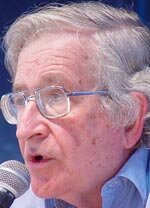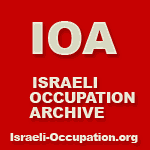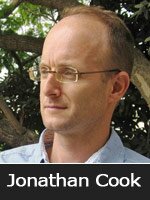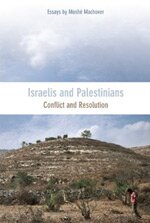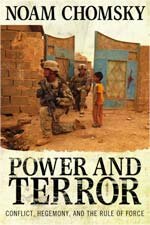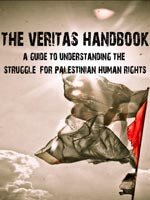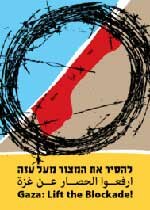By Amira Hass, Haaretz – 27 Nov 2009
www.haaretz.com/hasen/spages/1130944.html
Last Sunday, the water supply to the village of Arab al-Ramadin, south of Qalqilyah, was suddenly cut off. Anyone who used the remaining water in the rooftop tanks that morning heard only the frustrating sound of dry pipes by afternoon. In this tiny village of 300, running water is the only evidence of modern infrastructure.
The village was established in the early 1950s by Bedouin refugees whom Israel expelled from the Be’er Sheva area. They bought and leased land from the nearby village of Habla, tended sheep, and lived for 20 years expecting they would be able to return home soon, to the Negev. In the early 1970s, some of the inhabitants began building small concrete structures. Not too far away, on the lands of the Qalqilyah district to the east, the settlement of Alfei Menashe was founded in 1983.
Israel defines Arab al-Ramadin as illegal. Therefore, the Civil Administration refuses to connect it to the electricity grid or the roads, to include it in any zoning plans, or to issue building permits there.
Strewn haphazardly across a rocky hilltop about three kilometers east of the Green Line are the village’s tin shacks, animal pens and other makeshift structures. Starting around 6 P.M., the generators begin their loud rumble; due to the high cost of diesel fuel, they are used for only five or six hours a night.
This week, a spokesperson for the Coordinator of Government Activities in the Territories told Haaretz: “Due to the fact that the site in question contains illegally built structures, it is not possible to connect them to the infrastructure. Nevertheless, it was decided, with the agreement of the Alfei Menashe council and the Palestinian residents, as a neighborly and trust-building gesture, to connect Arab al-Ramadin to the settlement’s water pipeline.”
That was 15 years ago, villagers said this week. On Sunday, people were guessing that the water stoppage was not a malfunction, but had something to do with the council. They figured it was a response to an incident that occured late last Friday night: A donkey was wandering loose on the road, and a driver from Alfei Menashe – the daughter of council head Eliezer Hisdai – hit it, said the villagers. Hisdai already lost one daughter in a car accident, they added. They understood his anger, even though “the donkey is not ours,” as they tried to explain to the settlement’s security personnel who showed up the next day to warn them.
On Sunday afternoon, Hisdai confirmed he had ordered that the water be cut off, and said: “Why do you need to know the reason? Whoever knows the reason knows … so they won’t have water. They have the Civil Administration. Let it solve their water problem. It’s not my job. This is my municipal area. I didn’t say it was because of the donkey.”
The water supply was renewed later in the evening. A villager who works in the council contacted Haaretz and said that they apologized to Hisdai for the stray donkey.
More restrictions
Arab al-Ramadin is not within the jurisdiction of Alfei Menashe. But the village – like others in the vicinity – has been included since 1995 in Area C (constituting 61 percent of the West Bank, and under full Israeli control), which is dotted with settlements demanding the right to expand. The inclusion of the village in Area C, within the framework of the Oslo Accords, is another way of maintaining the ban on development that Israel imposed on the village long ago; it only institutionalizes and exacerbates a policy in force since 1967.
The Coordinator of Government Activities in the Territories told Haaretz: “The Civil Administration considers the Palestinian population’s fabric of life to be of great importance, and therefore has invested much effort on behalf of the residents of the Arab al-Ramadin tribe in an attempt to address the problem of their housing, most of which has been illegally built. It was proposed to give the Palestinian population of the region a permanent, regulated area, but the matter did not move forward due to the residents’ opposition. This solution, once implemented, would provide access to water, electricity and educational services.”
This statement does not specify the location of the proposed “permanent area” – but records of High Court hearings concerning a petition to alter the route of the separation fence show that the state stated back in 2004 that, “a proposal is being considered that [the residents of Arab al-Ramadin and Arab Abu Farda, an adjacent village established by Bedouin refugees from the Netanya area] move to a new, regulated site that will be built for them to the east of the enclave,” and that “it would be up to the inhabitants to accept such a proposal, which would not be imposed on them.”
Up to them? In June 2008, none other than the head of the Civil Administration, Yoav Mordechai, came and proposed to the residents that they move eastward, they say. They later told human-rights attorney Michael Sfard that during the visit, they were also explicitly told they would not be given building permits. Sfard wrote to Mordechai at the time, pointing out that he “even teased someone from the regional inspection unit, in the presence of the villagers, for not having noticed that a pirate asphalt road had been paved there.”
Kassab Khalil, a building contractor in the West Bank and a representative of Arab al-Ramadin, told Haaretz that about four months ago, the Civil Administration official in charge of Bedouin affairs also paid a visit.
In his letter to Mordechai, Sfard says the proposal to uproot the village is an expression of “the Civil Administration’s ‘transfer’ policy, whose aim is to ‘cleanse’ the seam area of its Palestinian inhabitants … Even if you believe that there is a big difference between forced transfer and so-called ‘voluntary transfer,’ the difference is really minimal.”
In response, the Civil Administration adamantly rejected the accusation that it has a transfer policy and wrote: “Extensive research is being done … to examine how to assist with and arrange for the housing of the entire Bedouin population in Judea and Samaria.”
Along a five-kilometer stretch, the separation fence built on behalf of Alfei Menashe twists and turns for 25 kilometers. It creates three enclaves: Qalqilyah is trapped in the northern one; two Palestinian villages are trapped in the southern one; and the central one – with Alfei Menashe spread out in the eastern part – blends into Israel thanks to a total blurring of the Green Line. A slight modification of the route as ordered by the High Court of Justice will remove three villages from the central enclave and include them in the southern one. However, most of the lands of one of the three villages, and the two Bedouin villages, will remain within the Alfei Menashe enclave. The Green Line exists only for them, and they may not cross over to the west.
What the building prohibitions and the inclusion in Area C failed to do, the separation fence has accomplished. It cut them off from Qalqilyah and the surrounding villages, and makes it more difficult and more expensive to obtain services there (whether medical, educational, commercial or governmental). Both villages have been cut off from their pasture lands and from the traditional markets for their dairy products. Most of Arab al-Ramadin’s 2,500 goats had to be sold after the villagers could not afford to care for them. Furthermore, since February 2000, residents have been accumulating unexecuted stop-work orders and demolition orders. At the seam-line checkpoint four kilometers east of the Green Line, they are restricted in terms of the food they can bring through (meat and eggs are prohibited), and cannot bring in “merchandise” – bulk goods – either.
Palestinian public transportation is not allowed to enter the enclave, which has been effectively annexed to Israel. The four taxis from Qalqilyah that have entry permits charge prices they cannot afford. Anytime a service provider needs to enter, it must be coordinated beforehand, and a special permit must be obtained from the Civil Administration. Visits from relatives also require special permits, which are issued only sparingly. No one expects to be able to have a friend visit.
Two weeks ago, a new directive was instated: For security reasons, the Israel Defense Forces is now prohibiting the nine car owners in the village from transporting other passengers (all residents of the enclave) through the checkpoint. They must disembark about a half-kilometer before the checkpoint, walk along a fenced-in path, undergo inspection and only then get back in the car. These rules apply to the sick, the elderly and the disabled, too. And in the rain and the dark and the cold. No wonder the villagers continue to suspect that the authorities and the settlements are bent on making the 1948 refugees “voluntarily” choose to leave. Yet again.




















